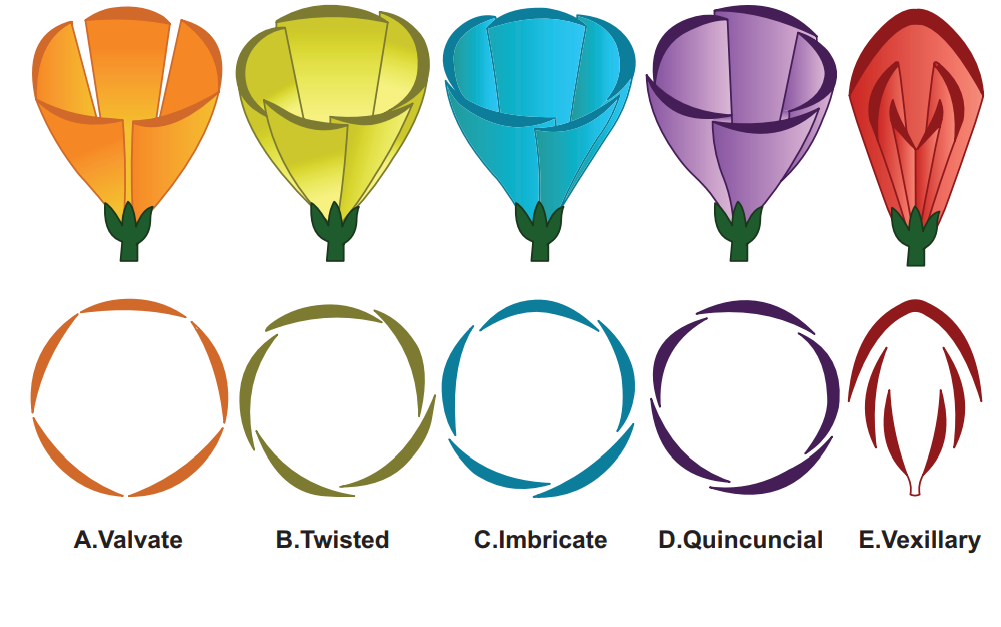
Aestivation found in pea flowers is
A. Twisted
B. Valvate
C. Imbricate
D. Vexillary
Answer
490.8k+ views
Hint: Sepals and petals are important parts of a flower. Sepals are modified leaves which encase the developing flower. Petals are sterile floral parts, which are visually appealing to attract pollinators to the flower. Aestivation is the manner in which petals or sepals are arranged in a flower bud with respect to the other members of the same whorl.
Complete answer
Five types of aestivations are present in the plants. They are Valvate, twisted, imbricate, vexillary and quincuncial aestivation.
Option A Twisted: In twisted aestivation, one margin of each sepal or petal overlaps on another petal. It is also called convolute or contorted. Example is petals of china rose
Option A is not correct
Option B Valvate: Here, margins or sepals or petals do not overlap each other. However, they just touch each other. Example is the calyx of Calotropis.
Hence, Option B is not correct
Option C Imbricate: Here, sepals and petals are irregularly overlapping each other. One petal is completely outside and one petal is completely inside. Remaining three petals possess one end inside and one outside. Example is Cassia
So, Option C is not correct
Option D Vexillary: In vexillary aestivation, large posterior petals overlap margins of lateral petals, which in turn, overlap anterior petals. Examples are peas and beans. Pea plant belongs to the family Fabaceae and sub-family Papilionaceae. The flowers of the plant possess the butterfly-shaped corolla having five petals. The posterior petal is the largest and is known as standard or vexillum. It overlaps the next two lateral petals, which are called wings. The wings then fuse and overlap with the anterior fused petals known as carcina or keel. This type of aestivation is called a descending imbricate, which is otherwise known as vexillary aestivation.
Option D is correct
Hence, Option D is the correct answer

Figure: Types of Aestivations
Note:
Aestivation is also the positional organisation of the sections of the flower inside the bud of the flower before it is opened. It is sometimes referred to as pre foliation or praefoliation. Bean also exhibits the vexillary aestivation. The other name for vexillary aestivation is papilionaceous aestivation. Quincuncial is a type of imbricate aestivation and is present in guava.
Complete answer
Five types of aestivations are present in the plants. They are Valvate, twisted, imbricate, vexillary and quincuncial aestivation.
Option A Twisted: In twisted aestivation, one margin of each sepal or petal overlaps on another petal. It is also called convolute or contorted. Example is petals of china rose
Option A is not correct
Option B Valvate: Here, margins or sepals or petals do not overlap each other. However, they just touch each other. Example is the calyx of Calotropis.
Hence, Option B is not correct
Option C Imbricate: Here, sepals and petals are irregularly overlapping each other. One petal is completely outside and one petal is completely inside. Remaining three petals possess one end inside and one outside. Example is Cassia
So, Option C is not correct
Option D Vexillary: In vexillary aestivation, large posterior petals overlap margins of lateral petals, which in turn, overlap anterior petals. Examples are peas and beans. Pea plant belongs to the family Fabaceae and sub-family Papilionaceae. The flowers of the plant possess the butterfly-shaped corolla having five petals. The posterior petal is the largest and is known as standard or vexillum. It overlaps the next two lateral petals, which are called wings. The wings then fuse and overlap with the anterior fused petals known as carcina or keel. This type of aestivation is called a descending imbricate, which is otherwise known as vexillary aestivation.
Option D is correct
Hence, Option D is the correct answer

Figure: Types of Aestivations
Note:
Aestivation is also the positional organisation of the sections of the flower inside the bud of the flower before it is opened. It is sometimes referred to as pre foliation or praefoliation. Bean also exhibits the vexillary aestivation. The other name for vexillary aestivation is papilionaceous aestivation. Quincuncial is a type of imbricate aestivation and is present in guava.
Recently Updated Pages
The number of solutions in x in 02pi for which sqrt class 12 maths CBSE

Write any two methods of preparation of phenol Give class 12 chemistry CBSE

Differentiate between action potential and resting class 12 biology CBSE

Two plane mirrors arranged at right angles to each class 12 physics CBSE

Which of the following molecules is are chiral A I class 12 chemistry CBSE

Name different types of neurons and give one function class 12 biology CBSE

Trending doubts
Explain zero factorial class 11 maths CBSE

What is 1s 2s 2p 3s 3p class 11 chemistry CBSE

Discuss the various forms of bacteria class 11 biology CBSE

An example of chemosynthetic bacteria is A E coli B class 11 biology CBSE

Name the metals and nonmetals in the first twenty class 11 chemistry CBSE

Which one of the following is not a method of soil class 11 biology CBSE




